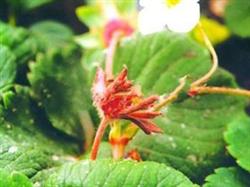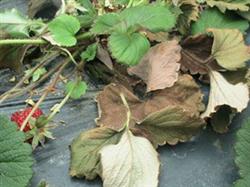Control techniques of pollution-free Diseases and insect pests of Strawberry

The characteristics of pollution-free pest control strawberry is a perennial herbaceous crop with high economic value, while China has a vast territory, complex and changeable climatic conditions, and great differences in the types and degree of diseases and insect pests. How to control strawberries in time is the key to high and stable yield of strawberries. The prevention and control of diseases and insect pests in pollution-free production should give priority to prevention and comprehensive control measures such as agriculture, biology, physics, chemistry, and so on. Integrated control is put forward in view of the resistance of diseases and pests after the extensive use of organic pesticides for a long time, which makes some secondary pests rampant and the environment is polluted. The aim is to coordinate the application of pesticides with biological control, to solve the contradiction between drug control and biological control, and to use all appropriate technologies to comprehensively control pests. From the ecological point of view, integrated control is to control the pest population to a low level, maintain a low-level pest population, feed natural enemies with pests, control pests with natural enemies, and use a variety of methods to control them. Starting from the overall ecosystem with pest population and plant as the center, giving priority to prevention, and in line with the principles of safety, effectiveness, economy and simplicity, we should organically coordinate the use of various control measures and control the occurrence of diseases and insect pests below the economic allowable level, so as to achieve the goal of high yield, high quality, low cost and no pollution. Strawberry plants are short and the stems, leaves and fruits are close to the ground, which provides good ecological conditions for the infection of many kinds of diseases and pests, especially the high temperature and humidity in protected cultivation, which is more suitable for the breeding of bacteria. In order to ensure the normal growth of strawberries and achieve the purpose of high quality and high yield, special emphasis should be placed on the adoption of comprehensive control measures based on agricultural control. (1) different varieties with disease resistance have different disease resistance and disease resistance. For example, in areas with heavy powdery mildew, varieties such as Baojiao Zaosheng, Induka and New Stars with strong resistance to powdery mildew can be selected; New Stars and Induka are resistant to snake eye disease; Baojiao Zaosheng and four Seasons strawberries are more resistant to Verticillium wilt; Baojiao Zaosheng, Induka, Xinxing and Gerrera are more resistant to root rot; Xinxing, Fengxiang and Chunxiang are more resistant to Fusarium wilt; Xinxing, Mingbao and Spike are resistant to gray mold. Therefore, the varieties with strong resistance to certain or several families should be selected according to the situation of different areas. (2) to cultivate strong virus-free seedlings, strawberry diseases and insect pests can easily occur from the seedling stage, and generally strong seedlings have strong disease resistance. therefore, it is very important to cultivate strong virus-free seedlings. Robust seedlings that meet the requirements should be cultivated in accordance with the seedling standards required by various cultivation types. (3) to reduce the spread of diseases and pests, such as viral diseases, red spiders, bud nematodes, root nematodes, etc., can be spread with seedlings. Therefore, strawberry seedlings should be strictly quarantined. Seedlings with quarantine objects are not allowed to be transported or introduced. The transmission of good seedlings is a very important pest control measure. Strict disinfection of seedlings and soil is one of the important measures to eliminate diseases and insect pests in situ. The seedlings were disinfected with 50% methyl topiramate or 25% carbendazim 1000-2000 times concentration before and after the plantlet; the soil was disinfected by solar energy. The cultivation of virus-free seedlings is an important measure to prevent seedlings from carrying diseases and insect pests. (4) strengthening the cultivation management of strawberry can effectively restrain the occurrence of diseases and insect pests. Apply sufficient basic fertilizer before planting to promote the healthy growth of strawberries; adopt high ridge planting, not too dense cultivation, improve ventilation and light transmission conditions; properly control the amount of nitrogen fertilizer and excessive irrigation to prevent overgrowth of plants; plastic film mulching to prevent fruit contact with soil, prevent pollution of fruits and rotten fruits; prevent high temperature and humidity, create a good growth environment; avoid continuous cropping and re-recommendation during planting to improve plant disease resistance Timely removal of diseased leaves, old leaves, remove weeds in the garden, keep the garden clean, and eliminate the source of bacterial infection. (5) using biological control and physical control to control diseases and insect pests of strawberries by using natural enemies, insect pathogens, agricultural antibiotics, insect sex hormones and some physical methods, with few side effects and no pollution. 1. The use of natural enemies to control pests should first protect natural enemies, reduce the use of broad-spectrum insecticides, or use drugs without affecting the activities of natural enemies; secondly, natural enemies can be released artificially, such as in protected cultivation, the pupae and adults of Coccinella septempunctata can be released timely to control aphids and other pests. 2. Using insect extra-sex hormone to set up a certain number of extra-sex hormone traps in strawberry orchard to trap a large number of adults, reduce the probability of natural mating of male and female adults, or interfere with the mating opportunity of insect pests, reduce the number of pests in strawberry orchard and achieve the effect of control. 3. According to the cluster trapping of some pests, light and color can be used to trap and kill pests or repellent insects, such as butter boards to kill aphids and whitefly. (6) the appropriate period for the rational application of chemical pesticides to control the pollution-free cultivation of strawberries is not that chemical pesticides cannot be used, but that they must comply with the national standards for the use of pesticides in pollution-free food production. On the basis of forecasting and forecasting work, the chemical control of diseases and insect pests should grasp the degree, scope and development progress of diseases and insect pests, and take measures in time. Implement the use of drugs at the seedling stage, early use of drugs, improve the lethality of pesticides to diseases and insect pests, improve the effect of prevention and control; carry out special treatment, reduce universal treatment; achieve multiple treatments with one drug, and treat diseases and pests at the same time. It is necessary to select biogenic pesticides, mineral pesticides and some pesticides with high efficiency, low toxicity and low residue, such as agricultural antibiotic 120, polyantimycin, Beauveria bassiana, Bacillus thuringiensis, avermectin, Bordeaux solution, Dasheng M-45, doxorubicin, ketol, diflubenzuron 3, miramine, aldicarb and so on. Some organic chemical pesticides allowed to be used should be limited, each pesticide should be limited to no more than once a year, and the standard for safe use of pesticides should be strictly enforced. The use of pesticides that have been banned by the state is strictly prohibited. Avoid the flowering and fruit ripening periods of strawberries.
- Prev

Symptoms and integrated control of strawberry bud blight
Strawberry bud blight is a worldwide soil fungal disease, which is highly saprophytic in soil, and is an important root disease of many kinds of crops. in addition to strawberry, it also harms more than 160 cultivated and wild plants, such as cotton, soybean, vegetable and so on. Strawberry is mainly harmful buds, new buds, stipules and petiole base, causing seedling withering.
- Next

Harm and comprehensive control of strawberry Verticillium wilt
Strawberry Verticillium wilt is a soil-borne disease. It is an important reason that affects and perplexes the expansion of strawberry production in recent years. Because strawberry is a perennial plant, after planting in the same field for many years, a large number of bacteria accumulate in the soil, coupled with the decline of variety disease resistance, poor field management and other factors, resulting in strawberry.
Related
- Moge, come on! The staff of the peasant association in the producing area of cantaloupe were frightened when the crowd gathered.
- Causes and Solutions of low Fruit setting rate of Apple
- Symptoms and control measures of passion fruit virus disease
- Fruit growing lesson: how do apple orchards keep high yields?
- Can you build orchards in the mountains? What are the pros and cons?
- How to manage the coloring period of Crisson grape?
- This paper introduces the processing technology of two kinds of fig products.
- How much is a month for retired teachers in rural areas by 2020?
- How can strawberry planting increase sugar content? We should pay attention to management in many aspects.
- What are the cultivation techniques on how to improve the yield of golden fruit?

